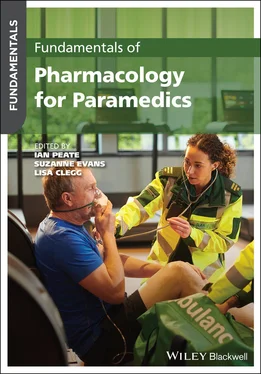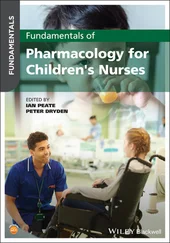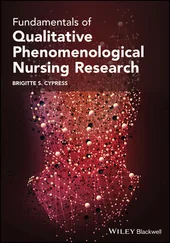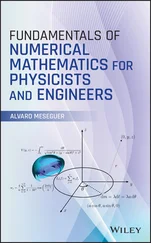Practise in a non‐discriminatory manner.
Understand the importance of and be able to maintain confidentiality.
Communicate effectively.
Work appropriately with others.
Maintain records appropriately.
Reflect on and review practice.
Assure the quality of their practice.
Understand the key concepts of the knowledge base relevant to their profession.
Draw on the appropriate knowledge and skills to inform practice.
Understand the need to establish and maintain a safe practice environment
In order to fulfil these requirements, paramedics must have a level of pharmaceutical knowledge and an awareness of how and where to find appropriate information to support clinical practice. Contemporary healthcare regimes have resulted in a breadth of emergent new products and complex treatment regimens. As a paramedic student or clinician, you will need up‐to‐date, clear and concise information to guide your practice. Examples of this can be found in later chapters in this book as well as external sources such as the JRCALC and numerous other guides, websites, texts and resources that are readily available. However, ensuring a robust and evidence‐based or evidence‐informed selection of these is paramount. Some resources are web based, some print based and some digital app based.
This chapter aims to introduce you to using pharmaceutical and prescribing reference guides with a specific focus on:
JRCALC Clinical Guidelines (JRCALC, 2019a)
JRCALC Pocket Book (JRCALC, 2019b)
JRCALC app.
Pharmaceutical and prescribing guides are vital and valuable resources to draw upon to ensure safe, accountable and evidence‐based paramedic practice and patient care.
As an undergraduate paramedic student or practising paramedic, there are core approaches to the fundamentals of medicines administration you should apply.
For example, when administering any drug, the paramedic should make sure they have a full understanding of its mechanism of action and the expected physiological effect it will have on the patient.
When out in practice, make sure you know where to easily access this information in your JRCALC so you can check it quickly in an emergency situation.
Joint Royal Colleges Ambulance Liaison Committee (JRCALC) Clinical Practice Guidelines
The JRCALC Clinical Practice Guidelines are an essential resource for paramedics and other healthcare professionals, in emergency care, on the road and in the community. The JRCALC books and app combine expert advice with practical guidance to ensure uniformity in the delivery of high‐quality patient care. The books, available as either the comprehensive reference edition or the pocket guide, cover a wide range of topics, from resuscitation, medical emergencies, trauma, obstetrics and medicines to major incidents and staff wellbeing. They include an extensive UK drugs formulary and Page for Age drugs tables to assist in making medicines administration simple. To date, the hard‐copy publication has been revised every 2–3 years. The digital version, via an app, is also available for prehospital clinicians to download. The electronic app version is updated more regularly.
The JRCALC Guidelines make reference to the National Institute for Health and Care Excellence (NICE) where appropriate. NICE guidelines inform the breadth of the National Health Service (NHS) in England and are also subject to regular review, update or withdrawal. Independent providers and ambulance services outside the UK should refer to their equivalent guidelines and institutions informing these.
 Paramedics must be aware that any subsequent changes in evidence‐based guidance after the date of any publication will not be incorporated within the published document. This emphasises the need for vigilance and awareness of possible emergent variations or changes in clinical practice and continuous professional development, as reflected within the HCPC paramedic standards of proficiency. This also supports the increasing use by paramedics of the more regularly updated digital format of the JRCALC Guidelines.
Paramedics must be aware that any subsequent changes in evidence‐based guidance after the date of any publication will not be incorporated within the published document. This emphasises the need for vigilance and awareness of possible emergent variations or changes in clinical practice and continuous professional development, as reflected within the HCPC paramedic standards of proficiency. This also supports the increasing use by paramedics of the more regularly updated digital format of the JRCALC Guidelines.
It is worth noting that the physical, hard‐copy JRCALC Guidelines text books are available through bookshops and are on sale separately from the digital app. The app is available to the public via the internet on a subscription basis. Ambulance trusts in the UK can also develop a ‘service‐specific’ version of the JRCALC app. This is referred to as the ‘JRCALC plus’, with most ambulance trust in the UK opting to use this resource for their employees rather than issuing hard‐copy books. Independent providers and ambulance services outside the UK who are interested in the ‘JRCALC plus’ option should contact the publisher direct. This JRCALC (app) resource offers the most current guidance as the digital format can be more easily updated.
Most of the content of the JRCALC Guidelines is universally applicable to NHS ambulance services. However, some modification of these may be evident in regional/individual ambulance services and independent and non‐UK ambulance service providers as approved by relevant clinical committees or equivalents to best meet the needs of local service users. Another area of modification to the JRCALC Guidelines for paramedics to be aware of may arise through research sanctioned by relevant research ethics committees.
JRCALC Update information
It is worth noting that the JRCALC Guidelines contain a section at the beginning of the text called ‘Update Analysis – “what’s changed?”’. This consists of a table containing update information about changes to specific guidelines since the last edition. It is split into sections which reflect those of the book, making it easy to find if there has been an update within the new JRCALC publication to a specific area of guideline since the previous edition ( Figure 2.1).
Always make sure you have a copy of your JRCALC Pocket Book or app with you.
If you use your Pocket Book, make sure you check regularly for any updates which have happened since your book was printed.
You may inadvertently administer a medication incorrectly if you have not kept up to date with the latest guideline changes.
The knowledge that informs the paramedic profession and the subsequent complex application of this to clinical skills and treatment interventions are constantly changing and updating in response to new research. It is essential for paramedics to keep up to date with the latest changes in policy and procedure. A paramedic who is already familiar with using the guidelines should read through the updated sections when a new edition is published to check any guideline changes which may affect their practice.

Figure 2.1 JRCALC Guidelines – Update Analysis.
Source: Reproduced with permission from JRCALC Guidelines (2019a).
How to navigate the JRCALC Guidelines
This is a comprehensive resource book containing a wide variety of clinical guidelines and information for paramedics on a broad range of topics. Such a large reference guide can seem daunting at first; however, the text is laid out in a logical order, making information easy to find and access. The resource book is split into seven main sections.
Читать дальше

 Paramedics must be aware that any subsequent changes in evidence‐based guidance after the date of any publication will not be incorporated within the published document. This emphasises the need for vigilance and awareness of possible emergent variations or changes in clinical practice and continuous professional development, as reflected within the HCPC paramedic standards of proficiency. This also supports the increasing use by paramedics of the more regularly updated digital format of the JRCALC Guidelines.
Paramedics must be aware that any subsequent changes in evidence‐based guidance after the date of any publication will not be incorporated within the published document. This emphasises the need for vigilance and awareness of possible emergent variations or changes in clinical practice and continuous professional development, as reflected within the HCPC paramedic standards of proficiency. This also supports the increasing use by paramedics of the more regularly updated digital format of the JRCALC Guidelines.











